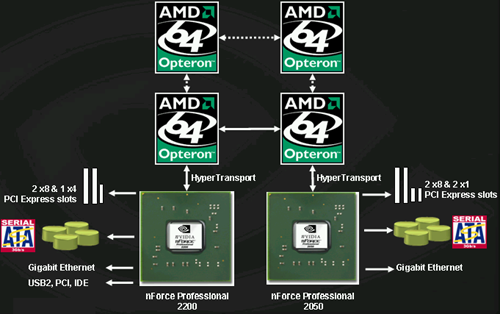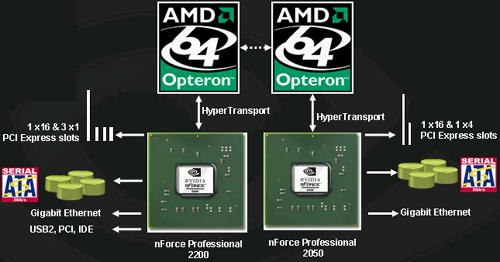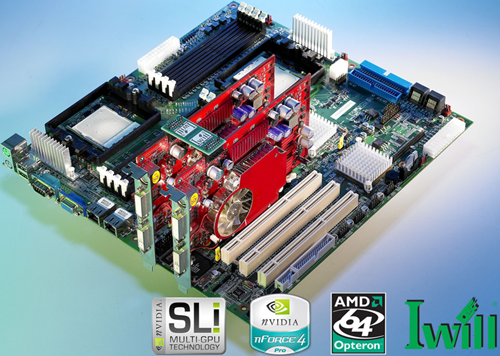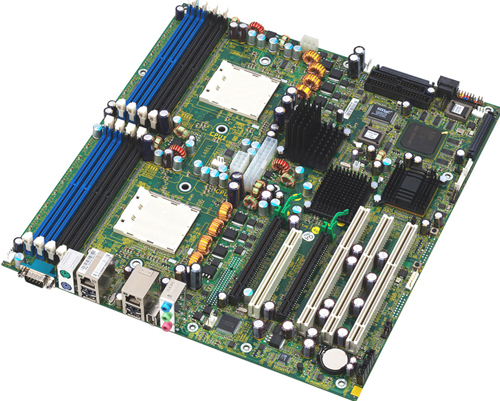NVIDIA nForce Professional Brings Huge I/O to Opteron
by Derek Wilson on January 24, 2005 9:00 AM EST- Posted in
- CPUs
The Kicker(s)
On server setups with available HyperTransport lanes to processors, up to 3 nForce Pro 2050 MCPs can be added alongside a 2200 MCP.
As each MCP makes a HT connection to a processor, a dual or quad processor setup is required for a server to take advantage of 3 2050 MCPs (in addition to the 2200), but in the case where such I/O power is needed, the processing power would be an obvious match. It is possible for a single Opteron to connect to one 2200 and 2 2050 MCPs for slightly less than the maximum I/O, as any available HyperTransport link can be used to connect to one of NVIDIA's MCPs. Certainly, the flexibility now offered by AMD and NVIDIA to third party vendors has been increased multiple orders of magnitude.
So, what does a maximum of 4 MCPs in one system get us? Here's the list:
- 80 PCI Express lanes across 16 physical connections
- 16 SATA 3Gb/s channels
- 4 GbE interfaces
Keep in mind that these features are all part of MCPs connected directly to physical processors with 1GHz HyperTransport connections. Other onboard solutions with massive I/O have provided multiple GbE, SATA, and PCIe lanes through a south bridge, or even the PCI bus. The potential for onboard scalability with zero performance hit is staggering. We wonder if spreading out all of this I/O across multiple HyperTransport connections and processors may even help to increase performance over the traditional AMD I/O topography.

Server configurations can drop an MCP off of each processor in an SMP system.
The fact that NVIDIA's RAID can span across all of the devices in the system (all 16 SATA 3Gb/s and the 4 PATA devices from the 2200) is quite interesting as well. Performance will be degraded by mixing PATA and SATA devices (as the system will have to wait longer on PATA drives), and likely, most will want to keep RAID limited to SATA. We are excited to see what kind of performance that we can get from this kind of system.
So, after everyone catches their breath from the initial "wow" factor of the maximum nForce Pro configuration, keep in mind that this will only be used in very high end servers using Infiniband connections, 10 GbE, and other huge I/O interfaces. Boards will be configured with multiple x8 and x4 PCIe slots. This will be a huge boon to the high end server market. We've already shown the scalability of the Opteron at the quad level to be significantly higher than Intel's Xeon (single front side bus limitations hurt large I/O), but unless Intel has some hidden card up their sleeve, this new boost will put AMD based high end servers well beyond the reach of anything that Intel could put out in the near term.
On the workstation side, NVIDIA will be pushing dual processor platforms with one 2200 and one 2050 MCP. This will allow the following:
- 40 PCI Express lanes across 8 physical connections
- 8 SATA 3Gb/s channels
- 2 GbE interfaces

This is the workstation layout for a DP NFPro system.
Again, it may be interesting to see if a vendor will come out with a single processor workstation board requiring an Opteron 2xx to enable a 2200 and 2050. This way, a single processor workstation could be had with all the advantages of the system.

IWill is shipping their DK8ES as we speak and should have availability soon.
While NVIDIA hasn't announced SLI versions of Quadro or support for them, boards based on the nForce Pro will support SLI version of Quadro when available. And the most attractive feature of the nFroce Pro when talking about SLI is this: 2 full x16 PCI Express slots. Not only do both physical x16 slots have all x16 electrical connections, but NVIDIA has enough headroom left for an x4 slot and some x1 slots as well. In fact, this feature is big enough to be a boon without the promise of SLI in the future. The nForce Pro offers full bandwidth and support for multiple PCI Express cards, meaning that multimonitor support on PCI Express just got a shot in the arm.
One thing that's been missing since the move away from PCI graphics cards has been multiple card support in systems. Due to the nature of AGP, running a PCI card alongside an AGP card is nice, but PCI cards are much lower performance. Finally, those who need multiple graphics cards will have a solution with support for more than one of the latest and greatest graphics cards. This means two 9MP monitors for some, and more than two monitors for others. And each graphics card has a full x16 connection back to the rest of the system.

Tyan motherboards based on nForce Pro are also shipping soon according to NVIDIA.
The two x16 connections will also become important for workstation and server applications that wish to take advantage of GPUs for scientific, engineering, or other vector-based applications that lend themselves to huge arrays of parallel floating point hardware. We've seen plenty of interest in doing everything from fluid flow analysis to audio editing on graphics cards. It's the large bi-directional bandwidth of PCI Express that enables this, and now that we'll have two PCI Express graphics cards with full bandwidth, workstations have even more potential.
Again, workstations will be able to have RAID across all 8 SATA devices and 4 PATA devices if desired. We can expect mid-range and lower end workstation solutions only to have a single nForce 2200 MCP on them. NVIDIA sees only the very high end of the market looking at pairing the 2200 with 2050 in the workstation space.
Perhaps the only down side to the huge number of potential PCI Express lanes available is the inability of NVIDIA MCPs to share lanes between MCPs and slight lack of physical PCI Express connections. In otherwords, it will not be possible to have a motherboard with 5 x16 PCI Express slots or 10 x8 PCI Express slots, even though there are 80 lanes available. Of course, having 4 x16 slots is nothing to sneeze at. On the flip side, it's not possible to put 1 x16, 2 x4, and 6 x1 PCIe slots on a dual processor workstation. Even though there are a good 16 PCI Express lanes available, there are no more physical connections to be had. Again, this is an extreme example, and not likely to be a real world problem. But it's worth noting nonetheless.










55 Comments
View All Comments
SDA - Monday, January 24, 2005 - link
Thanks, Kris, but I do know that PCI-X != PCI-Express.. a lot of people use it to mean that by mistake, though, so I'm not sure what the author meant by PCI-X on the last page of the article.Also, technically, PCI-X isn't quite 64-bit PCI. 64-bit PCI is, well, 64-bit PCI; the main difference between it and PCI-X is that PCI-X also runs at a faster clock (133MHz, or 266MHz for 2.0). Obsolete PC technology is one of the few things I have any knowledge about, heh.
REMF - Monday, January 24, 2005 - link
my mistake Derek, got the diagram muddled up with those hideous dual boards that connect all the memory through CPU0 and route it via HT to CPU1.mixed up memory with IO, silly me.
DerekWilson - Monday, January 24, 2005 - link
nf pro supports ncq and not tcq ...I also updated the article ... MCPs are more flexible than I thought and NVIDIA has corrected me on a point --
one 2200 and 2 2050s can connect to an Opteron 150. dual and quad servers are able to connect to 4 MCPs total (2 each processor for dual and 1 each for quad).
With 8-way servers, it's possible to build even more I/O in to the system. NVIDIA says their mostly targeting 2 and 4 way, but with 8 way systems, there are topographies that essentially connect 2 4-way setups together. In these cases, 6 MCPs could be used giving even more I/O ...
#21 ---
Every Opteron has 3 HT links ... the difference between a 1xx, 2xx, and 8xx is the number of coherent HT links. In a dual core setup, either AMD could use one of the 3 HT links for core to core comm, or they could add an HT link for intra core comm.
pio!pio! - Monday, January 24, 2005 - link
If I'm reading this correctly...with all those PCI Express slots and multiple MCP's and multiproc's...the number of traces in the mobo should be astronomically high..I wonder how expensive the motherboards will bejmautz - Monday, January 24, 2005 - link
Please correct my memory/misunderstanding...I thought the reason AMD could make a dual-core Opt so easilly was because they attached both cores via the unused HyperTrasport connector. Doesn't that mean there is no availible HyperTrasport conencters on to attch the 2050? (at least on the 22x models).
Thanks.
DerekWilson - Monday, January 24, 2005 - link
#18capable of RAID 0, 1, 0+1 ... same as NF4. The overhead of RAID 5 would require a much more powerful processor (or performance would be much slower).
#15
Quad and 8-way scientific systems with 4 video cards in them doing general purpose scientific computing (or any vector fp math app) comes to mind as a very relevant app ... I could see cluster of those being very effective in crunching large data science/math/engineering problmes.
#12/#13
NUMA and memory bandwidth has nothing to do with NVIDIA's nForce 4 or nForce Pro, or even AMD's chipsets.
Each Opteron has it's own on die memory controller, and the motherboard vendor can opt to impliment a system that would allow or disallow NUMA as they see fit. What's required is a bios that: has APIC 2, no node interleaving, and can build an SRAT. Also the motherboard must allow physical memory to be attached to each processors' memory controllers. It's really a BIOS and phsyical layout issue.
The NVIDIA core logic does do a lot for being single chip. But we should remember that it doesn't need to act as a memory controller as Intel's northbridge must. The nForce has no effect on memory config.
tumbleweed - Monday, January 24, 2005 - link
The Tech Report mentioned that the nForce Pro supports TCQ instead of just NCQ - is that wrong, or was that just not mentioned here?Doormat - Monday, January 24, 2005 - link
Perhaps I missed it, but what RAID modes is it capable of? 0/1/5? I'd love to have a board with 8 SATA-II ports and dual opteron processors and run RAID 5 as a file server (with 64b linux of course). Let the CPUs do the parity calcs (since that'd be the only thing its used for). Mmmm... 8x400GB in RAID-5.jmautz - Monday, January 24, 2005 - link
Thanks I see that now. When I missed it the first time I went back and looked at the summery specs on page 3 and didn't see it listed.Thanks again.
ProviaFan - Monday, January 24, 2005 - link
#14 / jmautz:On page 2 of the article, there is this statement:
"NVIDIA has also informed us that they have been validating AMD's dual core solutions on nForce Professional before launch as well. NVIDIA wants its customers to know that it's looking to the future, but the statement of dual core validation just serves to create more anticipation for dual core to course through our veins in the meantime. Of course, with dual core coming down the pipe later this year, the rest of the system can't lag behind."